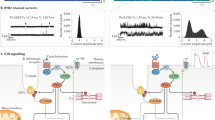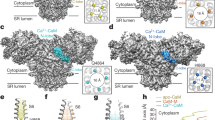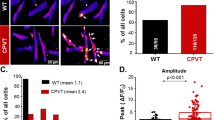Abstract
Spontaneous Ca2+ release from intracellular stores is important for various physiological and pathological processes. In cardiac muscle cells, spontaneous store overload–induced Ca2+ release (SOICR) can result in Ca2+ waves, a major cause of ventricular tachyarrhythmias (VTs) and sudden death. The molecular mechanism underlying SOICR has been a mystery for decades. Here we show that a point mutation, E4872A, in the helix bundle crossing region (the proposed gate) of the cardiac ryanodine receptor (RyR2) completely abolishes luminal, but not cytosolic, Ca2+ activation of RyR2. The introduction of metal-binding histidines at this site converts RyR2 into a luminal Ni2+-gated channel. Mouse hearts harboring a heterozygous RyR2 mutation at this site (E4872Q) are resistant to SOICR and are completely protected against Ca2+-triggered VTs. These data show that the RyR2 gate directly senses luminal (store) Ca2+, explaining the regulation of RyR2 by luminal Ca2+, the initiation of Ca2+ waves and Ca2+-triggered arrhythmias. This newly identified store-sensing gate structure is conserved in all RyR and inositol 1,4,5-trisphosphate receptor isoforms.
This is a preview of subscription content, access via your institution
Access options
Subscribe to this journal
Receive 12 print issues and online access
$209.00 per year
only $17.42 per issue
Buy this article
- Purchase on Springer Link
- Instant access to full article PDF
Prices may be subject to local taxes which are calculated during checkout






Similar content being viewed by others
References
Bers, D.M. Cardiac excitation-contraction coupling. Nature 415, 198–205 (2002).
Berridge, M.J., Bootman, M.D. & Roderick, H.L. Calcium signalling: dynamics, homeostasis and remodelling. Nat. Rev. Mol. Cell Biol. 4, 517–529 (2003).
Fabiato, A. Time and calcium dependence of activation and inactivation of calcium-induced release of calcium from the sarcoplasmic reticulum of a skinned canine cardiac Purkinje cell. J. Gen. Physiol. 85, 247–289 (1985).
Bers, D.M. Calcium cycling and signaling in cardiac myocytes. Annu. Rev. Physiol. 70, 23–49 (2008).
Irvine, R.F. 'Quantal' Ca2+ release and the control of Ca2+ entry by inositol phosphates—a possible mechanism. FEBS Lett. 263, 5–9 (1990).
Missiaen, L., Taylor, C.W. & Berridge, M.J. Spontaneous calcium release from inositol trisphosphate-sensitive calcium stores. Nature 352, 241–244 (1991).
Missiaen, L., Taylor, C.W. & Berridge, M.J. Luminal Ca2+ promoting spontaneous Ca2+ release from inositol trisphosphate-sensitive stores in rat hepatocytes. J. Physiol. (Lond.) 455, 623–640 (1992).
Nunn, D.L. & Taylor, C.W. Luminal Ca2+ increases the sensitivity of Ca2+ stores to inositol 1,4,5-trisphosphate. Mol. Pharmacol. 41, 115–119 (1992).
Sitsapesan, R. & Williams, A. Regulation of the gating of the sheep cardiac sarcoplasmic reticulum Ca2+-release channel by luminal Ca2+. J. Membr. Biol. 137, 215–226 (1994).
Bassani, J.W., Yuan, W., Bers, D.M. & Fractional, S.R. Ca release is regulated by trigger Ca and SR Ca content in cardiac myocytes. Am. J. Physiol. 268, C1313–C1319 (1995).
Györke, I. & Gyorke, S. Regulation of the cardiac ryanodine receptor channel by luminal Ca2+ involves luminal Ca2+ sensing sites. Biophys. J. 75, 2801–2810 (1998).
Xu, L. & Meissner, G. Regulation of cardiac muscle Ca2+ release channel by sarcoplasmic reticulum lumenal Ca2+. Biophys. J. 75, 2302–2312 (1998).
Shannon, T.R., Ginsburg, K.S. & Bers, D.M. Potentiation of fractional sarcoplasmic reticulum calcium release by total and free intra-sarcoplasmic reticulum calcium concentration. Biophys. J. 78, 334–343 (2000).
Jiang, D. et al. RyR2 mutations linked to ventricular tachycardia and sudden death reduce the threshold for store-overload–induced Ca2+ release (SOICR). Proc. Natl. Acad. Sci. USA 101, 13062–13067 (2004).
Keller, M., Kao, J.P., Egger, M. & Niggli, E. Calcium waves driven by “sensitization” wave-fronts. Cardiovasc. Res. 74, 39–45 (2007).
Kong, H. et al. Skeletal and cardiac ryanodine receptors exhibit different responses to Ca2+ overload and luminal Ca2+. Biophys. J. 92, 2757–2770 (2007).
Györke, S. & Terentyev, D. Modulation of ryanodine receptor by luminal calcium and accessory proteins in health and cardiac disease. Cardiovasc. Res. 77, 245–255 (2008).
Kass, R.S. & Tsien, R.W. Fluctuations in membrane current driven by intracellular calcium in cardiac Purkinje fibers. Biophys. J. 38, 259–269 (1982).
Orchard, C.H., Eisner, D. & Allen, D. Oscillations of intracellular Ca2+ in mammalian cardiac muscle. Nature 304, 735–738 (1983).
Stern, M.D., Kort, A., Bhatnagar, G. & Lakatta, E. Scattered-light intensity fluctuations in diastolic rat cardiac muscle caused by spontaneous Ca2+-dependent cellular mechanical oscillations. J. Gen. Physiol. 82, 119–153 (1983).
Wier, W.G., Kort, A., Stern, M., Lakatta, E. & Marban, E. Cellular calcium fluctuations in mammalian heart: direct evidence from noise analysis of aequorin signals in Purkinje fibers. Proc. Natl. Acad. Sci. USA 80, 7367–7371 (1983).
Marban, E., Robinson, S.W. & Wier, W.G. Mechanisms of arrhythmogenic delayed and early afterdepolarizations in ferret ventricular muscle. J. Clin. Invest. 78, 1185–1192 (1986).
Schlotthauer, K. & Bers, D.M. Sarcoplasmic reticulum Ca2+ release causes myocyte depolarization. Underlying mechanism and threshold for triggered action potentials. Circ. Res. 87, 774–780 (2000).
Bers, D.M. Calcium and cardiac rhythms: physiological and pathophysiological. Circ. Res. 90, 14–17 (2002).
Pogwizd, S.M. & Bers, D.M. Cellular basis of triggered arrhythmias in heart failure. Trends Cardiovasc. Med. 14, 61–66 (2004).
Jiang, D. et al. Enhanced store overload–induced Ca2+ release and channel sensitivity to luminal Ca2+ activation are common defects of RyR2 mutations linked to ventricular tachycardia and sudden death. Circ. Res. 97, 1173–1181 (2005).
Priori, S.G. & Chen, S.R. Inherited dysfunction of sarcoplasmic reticulum Ca2+ handling and arrhythmogenesis. Circ. Res. 108, 871–883 (2011).
Nelson, M.T. et al. Relaxation of arterial smooth muscle by calcium sparks. Science 270, 633–637 (1995).
Lakatta, E.G., Maltsev, V.A. & Vinogradova, T.M. A coupled system of intracellular Ca2+ clocks and surface membrane voltage clocks controls the timekeeping mechanism of the heart's pacemaker. Circ. Res. 106, 659–673 (2010).
Díaz, M.E., Trafford, A.W., O'Neill, S.C. & Eisner, D.A. Measurement of sarcoplasmic reticulum Ca2+ content and sarcolemmal Ca2+ fluxes in isolated rat ventricular myocytes during spontaneous Ca2+ release. J. Physiol. (Lond.) 501, 3–16 (1997).
Eisner, D.A., Kashimura, T., Venetucci, L.A. & Trafford, A.W. From the ryanodine receptor to cardiac arrhythmias. Circ. J. 73, 1561–1567 (2009).
Tripathy, A. & Meissner, G. Sarcoplasmic reticulum lumenal Ca2+ has access to cytosolic activation and inactivation sites of skeletal muscle Ca2+ release channel. Biophys. J. 70, 2600–2615 (1996).
Jiang, D., Chen, W., Wang, R., Zhang, L. & Chen, S.R.W. Loss of luminal Ca2+ activation in the cardiac ryanodine receptor is associated with ventricular fibrillation and sudden death. Proc. Natl. Acad. Sci. USA 104, 18309–18314 (2007).
Laver, D.R. Ca2+ stores regulate ryanodine receptor Ca2+ release channels via luminal and cytosolic Ca2+ sites. Biophys. J. 92, 3541–3555 (2007).
Liu, Y. et al. Flux regulation of cardiac ryanodine receptor channels. J. Gen. Physiol. 135, 15–27 (2010).
Györke, I., Hester, N., Jones, L.R. & Gyorke, S. The role of calsequestrin, triadin, and junctin in conferring cardiac ryanodine receptor responsiveness to luminal calcium. Biophys. J. 86, 2121–2128 (2004).
Knollmann, B.C. et al. Casq2 deletion causes sarcoplasmic reticulum volume increase, premature Ca2+ release, and catecholaminergic polymorphic ventricular tachycardia. J. Clin. Invest. 116, 2510–2520 (2006).
Sitsapesan, R. & Williams, A.J. Regulation of current flow through ryanodine receptors by luminal Ca2+. J. Membr. Biol. 159, 179–185 (1997).
Kong, H. et al. Caffeine induces Ca2+ release by reducing the threshold for luminal Ca2+ activation of the ryanodine receptor. Biochem. J. 414, 441–452 (2008).
Zhao, M. et al. Molecular identification of the ryanodine receptor pore-forming segment. J. Biol. Chem. 274, 25971–25974 (1999).
Williams, A.J., West, D.J. & Sitsapesan, R. Light at the end of the Ca2+-release channel tunnel: structures and mechanisms involved in ion translocation in ryanodine receptor channels. Q. Rev. Biophys. 34, 61–104 (2001).
Welch, W., Rheault, S., West, D.J. & Williams, A.J. A model of the putative pore region of the cardiac ryanodine receptor channel. Biophys. J. 87, 2335–2351 (2004).
Xu, L., Wang, Y., Gillespie, D. & Meissner, G. Two rings of negative charges in the cytosolic vestibule of type-1 ryanodine receptor modulate ion fluxes. Biophys. J. 90, 443–453 (2006).
Samsó, M., Feng, W., Pessah, I.N. & Allen, P.D. Coordinated movement of cytoplasmic and transmembrane domains of RyR1 upon gating. PLoS Biol. 7, e85 (2009).
Doyle, D.A. et al. The structure of the potassium channel: molecular basis of K+ conduction and selectivity. Science 280, 69–77 (1998).
Long, S.B., Campbell, E.B. & Mackinnon, R. Crystal structure of a mammalian voltage-dependent Shaker family K+ channel. Science 309, 897–903 (2005).
Payandeh, J., Scheuer, T., Zheng, N. & Catterall, W.A. The crystal structure of a voltage-gated sodium channel. Nature 475, 353–358 (2011).
Li, P. & Chen, S.R. Molecular basis of Ca2+ activation of the mouse cardiac Ca2+ release channel (ryanodine receptor). J. Gen. Physiol. 118, 33–44 (2001).
Shi, N., Ye, S., Alam, A., Chen, L. & Jiang, Y. Atomic structure of a Na+- and K+-conducting channel. Nature 440, 570–574 (2006).
Zhou, Q. et al. Carvedilol and its new analogs suppress arrhythmogenic store overload-induced Ca2+ release. Nat. Med. 17, 1003–1009 (2011).
Liu, N. et al. Arrhythmogenesis in catecholaminergic polymorphic ventricular tachycardia: insights from a RyR2 R4496C knock-in mouse model. Circ. Res. 99, 292–298 (2006).
Sedej, S. et al. Na+-dependent SR Ca2+ overload induces arrhythmogenic events in mouse cardiomyocytes with a human CPVT mutation. Cardiovasc. Res. 87, 50–59 (2010).
Mitchell, R.D., Palade, P. & Fleischer, S. Spontaneous calcium release from sarcoplasmic reticulum. Assessment of other ionic influences. J. Biol. Chem. 259, 1073–1081 (1984).
Fabiato, A. Two kinds of calcium-induced release of calcium from the sarcoplasmic reticulum of skinned cardiac cells. Adv. Exp. Med. Biol. 311, 245–262 (1992).
Watanabe, H. et al. Flecainide prevents catecholaminergic polymorphic ventricular tachycardia in mice and humans. Nat. Med. 15, 380–383 (2009).
Hilliard, F.A. et al. Flecainide inhibits arrhythmogenic Ca2+ waves by open state block of ryanodine receptor Ca2+ release channels and reduction of Ca2+ spark mass. J. Mol. Cell. Cardiol. 48, 293–301 (2010).
Sitsapesan, R. & Williams, A. The gating of the sheep skeletal sarcoplasmic reticulum Ca2+-release channel is regulated by luminal Ca2+. J. Membr. Biol. 146, 133–144 (1995).
Zhou, J., Launikonis, B.S., Rios, E. & Brum, G. Regulation of Ca2+ sparks by Ca2+ and Mg2+ in mammalian and amphibian muscle. An RyR isoform-specific role in excitation-contraction coupling? J. Gen. Physiol. 124, 409–428 (2004).
Dabertrand, F., Mironneau, J., Macrez, N. & Morel, J.L. Full length ryanodine receptor subtype 3 encodes spontaneous calcium oscillations in native duodenal smooth muscle cells. Cell Calcium 44, 180–189 (2008).
Ho, S.N., Hunt, H.D., Horton, R.M., Pullen, J.K. & Pease, L.R. Site-directed mutagenesis by overlap extension using the polymerase chain reaction. Gene 77, 51–59 (1989).
Fabiato, A. & Fabiato, F. Calculator programs for computing the composition of the solutions containing multiple metals and ligands used for experiments in skinned muscle cells. J. Physiol. (Paris) 75, 463–505 (1979).
Jiang, D., Xiao, B., Zhang, L. & Chen, S.R. Enhanced basal activity of a cardiac Ca2+ release channel (ryanodine receptor) mutant associated with ventricular tachycardia and sudden death. Circ. Res. 91, 218–225 (2002).
Hunt, D.J. et al. K201 (JTV519) suppresses spontaneous Ca2+ release and [3H]ryanodine binding to RyR2 irrespective of FKBP12.6 association. Biochem. J. 404, 431–438 (2007).
Guatimosim, S., Guatimosim, C. & Song, L.S. Imaging calcium sparks in cardiac myocytes. Methods Mol. Biol. 689, 205–214 (2011).
Wei, S. et al. T-tubule remodeling during transition from hypertrophy to heart failure. Circ. Res. 107, 520–531 (2010).
Semeniuk, L.M., Kryski, A.J. & Severson, D.L. Echocardiographic assessment of cardiac function in diabetic db/db and transgenic db/db-hGLUT4 mice. Am. J. Physiol. Heart Circ. Physiol. 283, H976–H982 (2002).
Laemmli, U.K. Cleavage of structural proteins during the assembly of the head of bacteriophage T4. Nature 227, 680–65 (1970).
Towbin, H., Staehelin, T. & Gordon, J. Electrophoretic transfer of proteins from polyacrylamide gels to nitrocellulose sheets: procedure and some applications. Proc. Natl. Acad. Sci. USA 76, 4350–434 (1979).
Thompson, J.D., Higgins, D.G. & Gibson, T.J. CLUSTAL W: improving the sensitivity of progressive multiple sequence alignment through sequence weighting, position-specific gap penalties and weight matrix choice. Nucleic Acids Res. 22, 4673–4680 (1994).
Jiang, Y. et al. Crystal structure and mechanism of a calcium-gated potassium channel. Nature 417, 515–522 (2002).
Schwede, T., Kopp, J., Guex, N. & Peitsch, M.C. SWISS-MODEL: an automated protein homology-modeling server. Nucleic Acids Res. 31, 3381–3385 (2003).
Guex, N. & Peitsch, M.C. SWISS-MODEL and the Swiss-PdbViewer: an environment for comparative protein modeling. Electrophoresis 18, 2714–2723 (1997).
Baker, N.A., Sept, D., Joseph, S., Holst, M.J. & McCammon, J.A. Electrostatics of nanosystems: application to microtubules and the ribosome. Proc. Natl. Acad. Sci. USA 98, 10037–10041 (2001).
Humphrey, W., Dalke, A. & Schulten, K. VMD: visual molecular dynamics. J. Mol. Graph. 14, 33–38 (1996).
Acknowledgements
This work was supported by research grants from the Canadian Institutes of Health Research (CIHR) to H.J.D., D.P.T. and S.R.W.C., the US National Institutes of Health to J.C., L.-S.S., M.F. and S.R.W.C., the Heart and Stroke Foundation of Alberta to A.M.G., H.J.D. and S.R.W.C. and the Canada Foundation for Innovation (S.R.W.C.) and by the Heart and Stroke Foundation/Libin Cardiovascular Institute Professorship in Cardiovascular Research (S.R.W.C.). We are grateful for generous donations from the King family, the Howarth family and the Libin Cardiovascular Institute of Alberta. We are also grateful to W.C. Claycomb from the Louisiana State University Health Sciences Center for kindly providing the HL-1 cardiac cell line and to J. Lytton from the University of Calgary for the gift of the β-actin–specific antibody. W.C., X.Z. and X.T. are recipients of the Alberta Innovates-Health Solutions (AIHS) Studentship Award; P.P.J. is a recipient of AIHS and Heart and Stroke Foundation Fellowship Awards; M.L.O. is the recipient of a CIHR Fellowship Award; and H.J.D., D.P.T. and S.R.W.C. are recipients of AIHS Scientist Awards.
Author information
Authors and Affiliations
Contributions
W.C., R.W., B.C., X.Z., H.K., Y.B., Q.Z., A.G., X.T., P.P.J., M.L.O., J.C., D.P.T., A.M.G., H.J.D., M.F., L.-S.S. and S.R.W.C. designed research. W.C., R.W., B.C., X.Z., H.K., Y.B., Q.Z., C.X., Jingqun Zhang, A.G., X.T., P.P.J., M.L.O., Y.L., T.M., L.Z., J.B., L.S., H.C. and Jianlin Zhang performed research. W.C., R.W., Y.B., X.Z., H.K., Y.B., Q.Z., C.X., Jingqun Zhang, A.G., X.T., P.P.J., M.L.O., Y.L., T.M., L.Z., J.B., Jianlin Zhang, L.-S.S. and S.R.W.C. analyzed data. W.C., X.Z., Y.B., P.P.J., M.L.O., M.F., L.-S.S. and S.R.W.C. wrote the paper.
Corresponding author
Ethics declarations
Competing interests
The authors declare no competing financial interests.
Supplementary information
Supplementary Text and Figures
Supplementary Figures 1–8 and Supplementary Table 1. (PDF 6586 kb)
Rights and permissions
About this article
Cite this article
Chen, W., Wang, R., Chen, B. et al. The ryanodine receptor store-sensing gate controls Ca2+ waves and Ca2+-triggered arrhythmias. Nat Med 20, 184–192 (2014). https://doi.org/10.1038/nm.3440
Received:
Accepted:
Published:
Issue Date:
DOI: https://doi.org/10.1038/nm.3440
This article is cited by
-
RCN2 promotes Nasopharyngeal carcinoma progression by curbing Calcium flow and Mitochondrial apoptosis
Cellular Oncology (2023)
-
Ligand sensitivity of type-1 inositol 1,4,5-trisphosphate receptor is enhanced by the D2594K mutation
Pflügers Archiv - European Journal of Physiology (2023)
-
New drug discovery of cardiac anti-arrhythmic drugs: insights in animal models
Scientific Reports (2023)
-
Caffeine blocks SREBP2-induced hepatic PCSK9 expression to enhance LDLR-mediated cholesterol clearance
Nature Communications (2022)
-
The function and regulation of calsequestrin-2: implications in calcium-mediated arrhythmias
Biophysical Reviews (2022)



